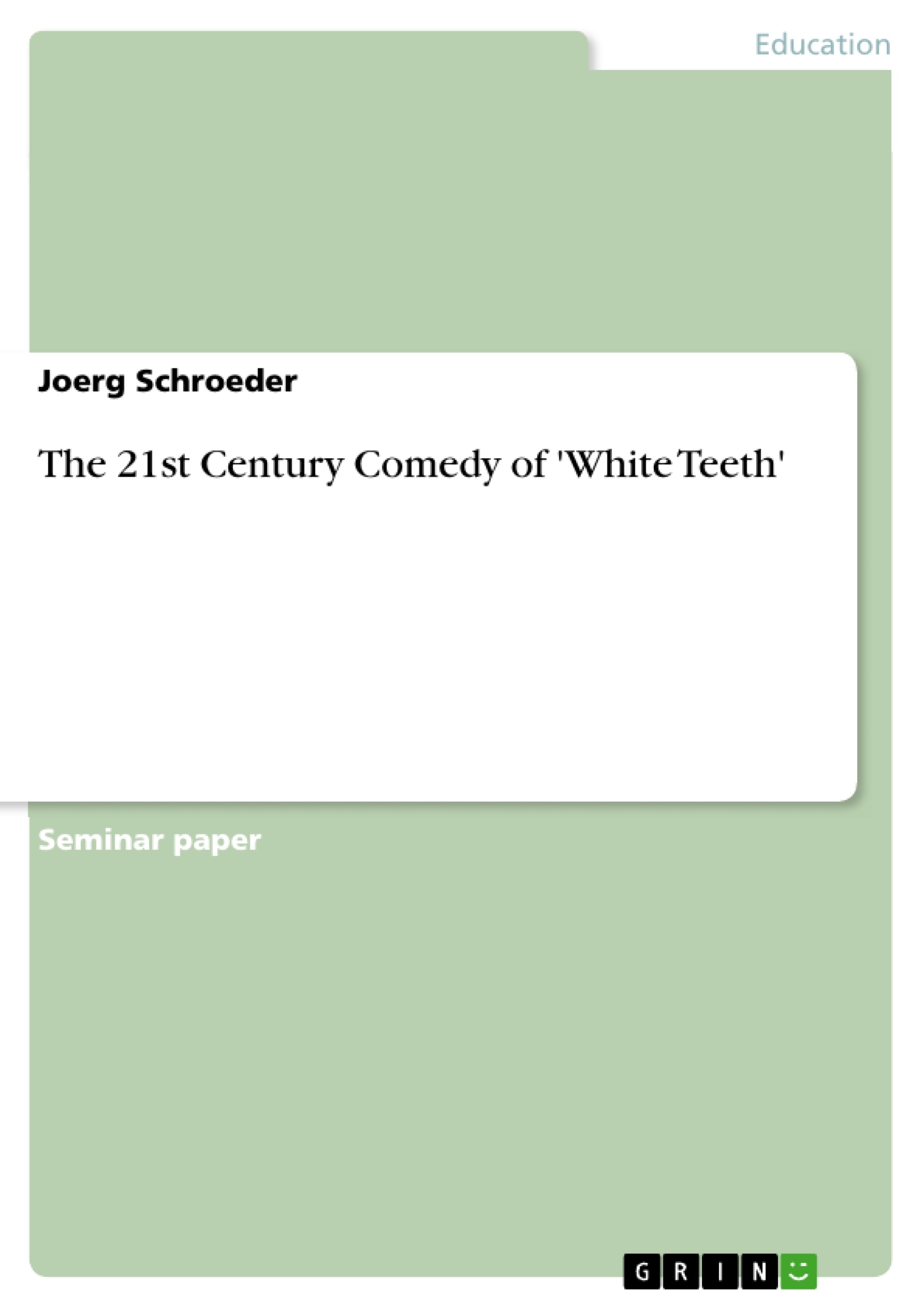The 21st Century Comedy of White Teeth
Contents
1. Polyglot Plot
1.1. Flexible omniscient narrator
1.2. Forwarded Reversals
2. Transnational Locations
2.1. Colours of Culture
2.2. Irish Storytelling
2.3. Transcultural Veto
3. Comedy
3.1. Generic Gear
3.2. Comedic Crossings
3.2.1. Mad Mary
3.2.2. Arabian Mickey
3.2.3. Samad & Women
3.3. Male Mockery
3.3.1. Anti-hero Archie
3.3.2. Protagonist Samad
3.3.3. Old School
4. Conclusion
5. Bibliography
"It is useless to base any system on a human being." (Henri Bergson. Laughter. 1900)
White Teeth is both an ample and intense read as well as a bestselling success after its first publication in 2000. It has found its creative way via television adaptation and a four-hour
long theatre play into the school curriculum. In my term paper I will show that White Teeth is a comedy for the 21st century generated through a polyglot plot and transnational locations.
Mostly based on the first half of the novel, it is where I could draw up my hypotheses. Archibald Jones’ and Samad Iqbal’s male friendship is affiliated with society and culture, and therefore useful on reflexion. Their synchronized mid-life crises move towards conflicts exposed in the amusing narrative. Critically user-oriented but limited due to paper-size, I will try to converge to the multilateral scope of new fiction.
While researching secondary literature published in the 2000s about postcolonial and transnational corpora many authors claimed superordinate terminology adhered to Zadie Smith’s début novel White Teeth. Nonetheless, serious analytical debates were missing an
essential genre making literature enjoyable more than ever. In this term paper, my aim is to prove that Zadie Smith escaped the compelling hassle of both a début and millennium novel by jocular updating of contemporary English-speaking literature.
1. Polyglot Plot
The promising twenty-something writer, the English-Jamaican Zadie Smith, was supported by her husband and laywer come poet, the Northern Irish Nick Laird, who published her poetry before her literary fame. She graduated in English literature at Cambridge university with her epic début White Teeth that became a sensational best-seller, TV adaptation and theatre play.
Creative writing about deprived war veterans and their respective multicultural families is syncopated by boisterous jokes. I will elucidate the transnational comedy that is about to unfold in a 542-paged volume.
[...]
Table of Contents
- Polyglot Plot
- Flexible omniscient narrator
- Forwarded Reversals
- Transnational Locations
- Colours of Culture
Objectives and Key Themes
This term paper aims to demonstrate that Zadie Smith's debut novel, White Teeth, transcends the typical constraints of both a debut novel and a millennium novel by utilizing a humorous and contemporary approach to English-speaking literature. The paper explores the novel's unique narrative techniques and its portrayal of transnational locations, ultimately revealing the novel's comedic nature and its significance within the postcolonial and transnational discourses of the early 21st century.
- The novel's transnational comedy generated through a polyglot plot and transnational locations.
- The significance of the novel's narrative structure, particularly the flexible omniscient narrator and the use of forwarded reversals.
- The role of transnational locations, specifically London, in shaping the novel's themes and narrative.
- The novel's portrayal of multiculturalism and the complexities of identity in a postcolonial world.
- The novel's relevance within the broader context of contemporary English-speaking literature and its engagement with postcolonial and transnational discourses.
Chapter Summaries
The paper focuses primarily on the first half of the novel, analyzing the narrative techniques and themes that contribute to the novel's comedic nature. The first chapter, "Polyglot Plot," examines the novel's flexible omniscient narrator and its use of forwarded reversals, highlighting how these techniques contribute to the novel's unique blend of humor and social commentary. The second chapter, "Transnational Locations," explores the importance of London as a site of multiculturalism and the novel's representation of different cultural groups and their interactions. This chapter also delves into the novel's use of color imagery to portray the diverse tapestry of London society.
Keywords
Key themes and concepts addressed in the paper include: transnational comedy, polyglot plot, flexible omniscient narrator, forwarded reversals, transnational locations, postcolonial London, multiculturalism, identity, diversity, and contemporary English-speaking literature.
- Arbeit zitieren
- Joerg Schroeder (Autor:in), 2012, The 21st Century Comedy of 'White Teeth', München, GRIN Verlag, https://www.grin.com/document/194532



